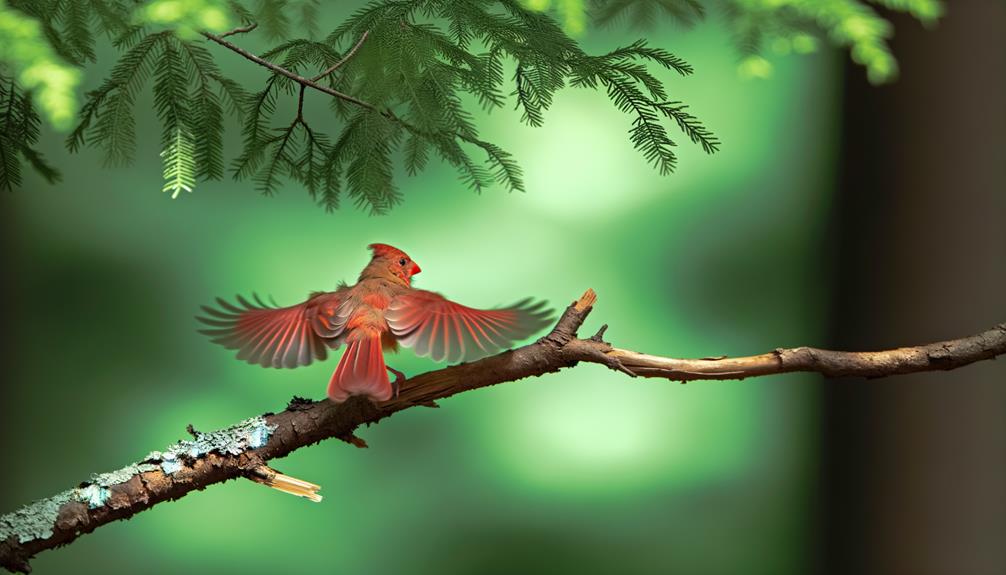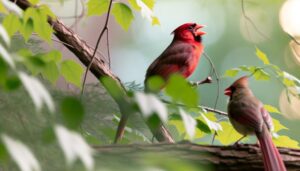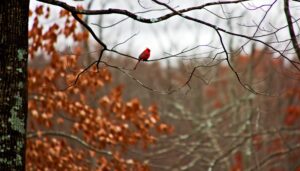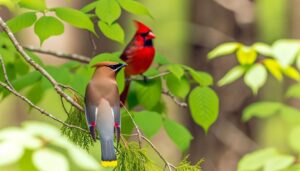3 Phases of Baby Cardinals Learning to Fly
Watching a baby cardinal learn to fly is fascinating. You'll notice they start by instinctively opening their mouths for feeding and huddling together for warmth.
As they grow, they exercise their wings, flapping vigorously to build pectoral muscles. When they're ready for first flight attempts, they teeter on the nest edge, fluttering their wings and making delicate movements.
Coordination and muscle strength grow as they practice short, controlled flights. They develop spatial awareness and refine their landings, gradually gaining independence.
Their journey from cautious wing flutters to confident flight is a detailed process you'll find intriguing.

Key Takeaways
- Baby cardinals flap their wings vigorously in the nest to develop flight muscles.
- First flight attempts involve delicate balance, tiny movements, and feather fluttering.
- Short, controlled flights from perch to perch help refine coordination and muscle strength.
- Exploring the environment and covering longer distances are key to gaining independence.
- Soft calls and short jumps signify early stages of flight learning.
Hatching and Early Days
Newly hatched baby cardinals frequently exhibit instinctual behaviors crucial for their survival, such as begging for food and remaining close to the nest.
You'll notice that these hatchlings, often referred to as nestlings, instinctively open their mouths wide to signal their parents for feeding. This behavior ensures they receive the necessary nutrients for growth.
They also stay huddled together for warmth and protection since their initial feathers provide minimal insulation. The nest offers a secure environment, safeguarding them from potential predators and harsh weather.
Additionally, these early days are essential for the development of their sensory and motor skills. Observing these behaviors, you can see how their survival depends on both their instinctual actions and the care provided by their parents.
Developing Flight Muscles
As baby cardinals grow, they engage in repeated wing exercises that are vital for developing the strength and coordination needed for flight. You'll notice them flapping their wings vigorously while still in the nest. This activity is necessary for building the pectoral muscles, which are responsible for powering flight.
Observing closely, you'll see them stretching and fluttering their wings daily, gradually increasing the intensity and frequency of these movements. This conditioning phase is important as it prepares them for the demands of sustained flight. Their muscles must develop to support their body weight and enable agile maneuvers.
First Flight Attempts
How remarkable it is to witness a baby cardinal's initial attempts at flight, as they teeter on the edge of the nest, wings trembling with anticipation. You can observe the fledgling's delicate equilibrium, tiny movements, and the slight flutter of feathers as it prepares to leap. It's a moment filled with both excitement and uncertainty. The following table highlights key observations during these first flight attempts:
| Observation | Description | Significance |
|---|---|---|
| Wing Quiver | Rapid, slight wing movements | Indicates muscle readiness |
| Balance | Wobbly, unsteady stance | Shows initial coordination efforts |
| Vocalization | Soft calls | Communication with parents |
| Leap | Short, hesitant jumps | First step in flight learning |
| Rest Period | Frequent pauses | Energy conservation and recovery |
Every detail is essential, revealing the intricate process of mastering flight.
Overcoming Challenges
Mastering the numerous challenges of early flight, a baby cardinal must refine its coordination, strengthen its muscles, and develop spatial awareness to ensure successful airborne journeys.
You'll observe the baby cardinal practicing short, controlled flights from perch to perch. Each attempt demands precise wing movements and balance adjustments, vital for avoiding falls.
You'll notice it flapping vigorously to build muscle strength, particularly in the wings and chest. Spatial awareness is honed as it navigates through branches and obstacles, learning to judge distances accurately.
The young bird's eyes and brain work together to map the environment, essential for safe landings. By repeatedly facing these challenges, the baby cardinal gradually becomes adept at flying, preparing for more complex aerial maneuvers.
Gaining Independence
Often, the baby cardinal's journey toward gaining independence involves increasingly longer flights and greater distances from its nest. You'll observe that as it matures, it begins to explore its environment more extensively. This period is vital for developing essential survival skills. Monitoring its growth, you'll notice specific milestones:
| Milestone | Description |
|---|---|
| Day 1-3 | Short, initial flights, usually within sight. |
| Day 4-7 | Gradual increase in distance covered. |
| Day 8-10 | Frequent foraging trips, learning food sources. |
| Day 11-14 | Practicing landing and takeoff proficiency. |
| Day 15+ | Extended flights, rarely returning to nest. |
Each stage demonstrates the cardinal's growing confidence and self-reliance. By observing these behaviors, you gain insights into how young cardinals progress to adulthood.
Conclusion
You've witnessed the incredible journey of a baby cardinal learning to fly. Did you know that only about 50% of fledglings survive their first year? This statistic underscores the challenges these tiny birds face.
As you watch them gain independence, remember the intricate process of muscle development, the tentative first flights, and the obstacles they overcome. Observing their resilience and determination offers a fascinating glimpse into the complexities of avian survival and growth.






